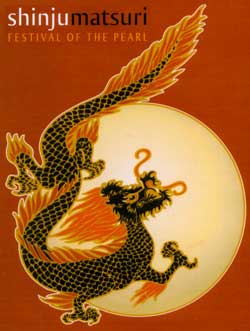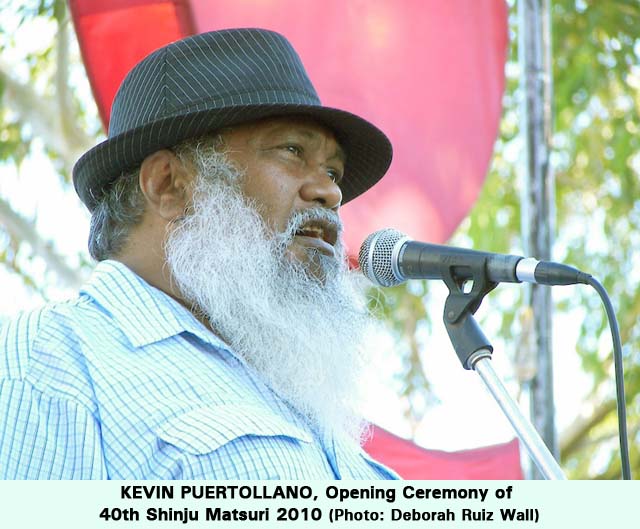KASAMA Vol. 24 No. 3 / July-August-September 2010 / Solidarity Philippines Australia Network
“Liyan is your heart feeling, liyan is spirit”
Broome is renowned for its multiculturalism and the festival that celebrates it turns 40 years in 2010. Patron of Shinju Matsuri 2010, KEVIN PUERTOLLANO, says it is an important time for locals to celebrate, to catch up, to put aside problems and work together. In an interview with ABC Radio Kimberley’s VANESSA MILLS, he recalls how Broome in the past revolved around pearling, the tides and the full moon; of luggers lined up along the sands of Dampier Creek; of family feasts and parties.
 Kevin Puertollano, ABC Radio Kimberley, Broome,
Kevin Puertollano, ABC Radio Kimberley, Broome,
25 August 2010, edited extracts:
At the beginning of the lugger season [when I was young] there used to be what we called the lugger picnics … to invite the people on the luggers to have a feast and to ensure … a good season. At the end of the season there was a closing festival. And this was a spirituality thing for good hearts and good living.
It was a fantastic time; as kids, we really enjoyed it. My father used to work on the luggers as an engine hand, he had to ensure the air flow to the divers. He worked there for a couple of years with Male & Co. in the 1940s. And my great grandfather, my father’s grandfather, worked for the Mission. And he also worked on The Ethel for Biddles back in the early days before he decided to work on land.
I also worked in the PPL, Pearl Pty Ltd, and Streeter & Male at the boatshed doing repairs to the luggers. My brother joined me working there in the 70s & 80s. I used to fix the steelwork on the luggers, repairing fuel tanks, putting new chain winches on and all those sort of things. And also rigging the first radar in Broome on top of a lugger mast. I had to design it myself because there were no drawings or anything so I had to try and work out how to ensure that, with the sway of the lugger in the ocean, it would be stable enough not to snap the mast … It worked, it was up there for years. I think one of them is still up there, so it was good.
There was a place called Morgan’s Camp where the post office is located now. That used to be called Burrgugun. And the Yawuru people gave it to the Bard people to live because the Bard people had no place to go, so the Yawuru people allowed them to stay there. And over the many years they lived around there. And as you came round the mangroves you had Streeter & Male and as you came further up the coast there was … another old pearling mob … and all along the coast there were different boatsheds for repairing the luggers.
They used to bring in turtles, fish and dried pearl meat for the people ... My mother who was always mistaken to be a Japanese … they used to give her all these trinkets and food. And when she got married to my father, a part-Filipino, they lived on the foreshore there. The Japanese would always come in there with turtle and all that and we used to all enjoy it when the luggers came in.
There are many [cultures in Broome] and there will always be. When I talk about ‘multicultural’ I don’t just talk about the Asian culture … multicultural is also the Europeans too because many of them are multicultural, they have many different national [bloodlines] behind them. So, we are all multicultural in a sense. We all should be proud of that because being proud of it makes you know who you are. If you’re not proud in a little bit of your side of history it means that you don’t embrace what goes on in your life. Embracing everything makes you happy, makes you feel good, makes your, what we call, ‘liyan’ feel good. Liyan is your heart feeling, liyan is spirit. It’s something that I’ve really embraced this year to take forward and the reconciliation which is part of [this Shinju’s] theme has been happening for many years in terms of the different cultures that have been celebrated in Broome. I’d hate to see Shinju die in any way because it’s a spiritual festival that is embraced by all people not just the Asian people.

My great grandfather [Thomas Puertollano] came here from the Philippines and he passed on many of his ways of how Filipino food is prepared and I’ve learnt the different aspects of the food that Filipino people have. And this not only came from my father but my mother also because many of the Filipinos had fish traps and that around the place. My great grandfather had a place across the creek called Kunin and he had his fish traps there and they used to walk across the creek when the tide was out and bring their fish into town and ride their bikes around town and sell fish. My father also built a fish trap and did the same things that his grandfather did … I used to go with him and my younger brother, and we’d clean the fish traps and help him sell the fish.
This skill was passed down and that’s one of the reasons why I decided in 2008 to build a fish trap and put it on a truck [for the Shinju Matsuri float parade]. Many people didn’t believe I could achieve that and I proved them wrong … I should really take this opportunity [to thank the Filipino community] because without their help and input that wouldn’t have happened. And it’s one of those things that is good about, not only the Filipinos, but also the Chinese, the Japanese, the Malays – they all chip in. When someone starts something, they see it coming to fruition, and they all come and want to be involved and help out and do things. Many have done that and I thank them for it.
I think many of the locals have been in various floats before as children, and now they’re grown up they should start to think of who they are and try to put together something that will give rise to their standing in the community. The Aboriginal people had their floats too … and it’s fantastic to watch. I’ve taken lots of photos of [the parade] and I’ve especially enjoyed seeing the kids’ faces. When you’re in the float itself and you see the people in the crowd admiring those floats and you see the joy in their faces, well, this is what we come here for. This is why the float parade happens, to bring joy and enlightenment to people and help them to see there are things they can achieve if they try and do it themselves too. And there’s many things they can do. You just have to start from a seed. Somebody puts the ideas, somebody starts to work on it and everybody gets involved. Family and friends get involved to do it and that’s how you achieve something.
Further Reading:


 Home | Aims and Objectives of Solidarity Philippines Australia Network | About Kasama
Home | Aims and Objectives of Solidarity Philippines Australia Network | About Kasama 